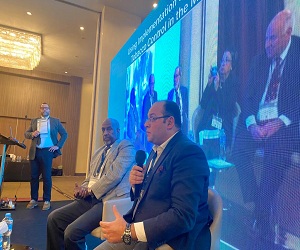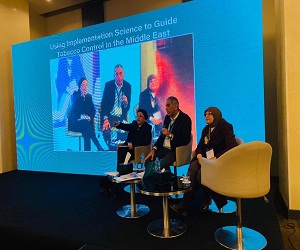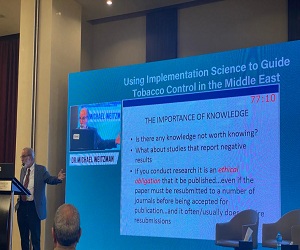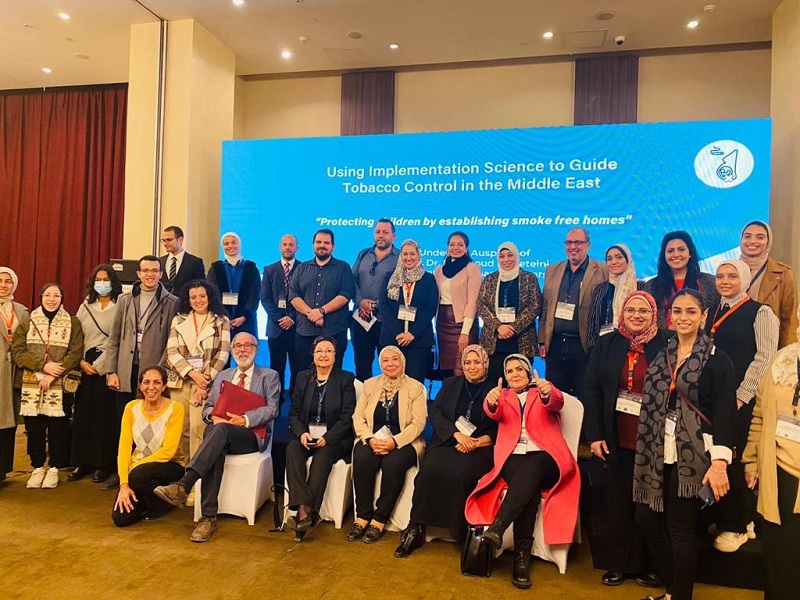Recommendations of the conference announcing the results of the project "Developing the capacities of health care providers in Egypt to apply counseling to pregnant women and their families to quit smoking"
Yesterday, Tuesday, January 31, 2023, the activities of the conference announcing the completion of the activities of the research project “Developing the capabilities of health care providers in Egypt to apply advice to pregnant women and their families regarding smoking cessation and avoiding active or passive smoking,” which was implemented at the Department of Public Health at the Faculty of Medicine, University of Cairo, ended. Ain Shams, under the supervision of the principal investigator of the project, Prof. Wageda Abdel Rahman Anwar, Professor of Public Health at the Faculty of Medicine, Ain Shams University, in cooperation with New York University, is represented by Prof. Omar Al-Shahawi and Prof. Scott Sherman, and with the participation of the work team at the Obstetrics and Gynecology Hospital in Demerdash Hospitals and the Ministry of Health and Population in Egypt.
The discussions concluded that exposure to smoking before birth by the mother, father, or others in the home, or exposure during childhood, leads to a lower birth weight, and higher death rates than the natural proportions of sudden infant death syndrome, and there is also an increase in ear infections and poor hearing, more and worse asthma, lower IQ in children and higher rates of attention deficit syndrome, tooth decay and more complications among overweight children.
The discussions also concluded that smokers and those who are exposed to secondhand smoke are more likely to be depressed and children who are exposed to secondhand smoke have more behavioral and mental problems and, later in life, are more likely to develop cancer than those who were not exposed to secondhand smoke.
 |
 |
 |
||
The discussions also emphasized that the air in the house, even in rooms where no one smokes hookahs, cigarettes or uses electronic cigarettes, is still very polluted, but it is worse in the room where smoking takes place, while clarifying that smoking hookahs at home exposes children Compulsory smoking is more harmful than smoking cigarettes or e-cigarettes.
The conference, which lasted for two days, with the participation of local and international experts, came out with a set of recommendations, including the assertion that it is not permissible for anyone in the house of a pregnant woman or children to smoke, and if they must smoke, it must be in a room far from children and from Better to smoke outside or stop smoking altogether.
The obstetricians, pediatricians, family doctors and nurses should advise parents about every time a pregnant woman or child goes to the doctor.
Social media messages should also be developed after qualitative research shows which messages work most effectively.
The conference also recommended that there should be regulations that prevent smoking in public places or public housing, with very large taxes on hookahs, cigarettes and electronic cigarettes.
 |
 |
 |
||
The conference stressed the importance of spreading awareness about tobacco use and its impact on pregnancy, raising the efficiency of health workers (doctors and nurses) to provide counseling for pregnant women regarding smoking and passive smoking, and disseminating the evidence-based training curriculum to provide advice to pregnant women about quitting tobacco use. Avoid passive smoking, and provide it to health service providers in hospitals and health centers. And make it one of the elective courses for students.
The conference also demanded that awareness messages be directed through admonitions in audio and visual media, as well as through social series and family dramas about smoking and its problems, to make it a social stigma, and to address the community in innovative ways that motivate them to quit smoking, with an emphasis on the role of civil society and the media to achieve smoke-free homes. Smoking and cooperation with civil society to provide guidance for those who want to quit smoking
Encouraging researchers to document their research and training them in distinguished scientific writing.
Benefit from the results of research on smoking and its harm to health, especially on children and pregnant women.
Encouraging smoke-free homes in Egypt and continuing dialogue among researchers on how to quit smoking
The conference also recommended the continuation of discussion sessions on future ways of cooperation, benefiting from the health community and the experiences of the participants, encouraging scientific research and cooperation with all local and international stakeholders, in cooperation with government agencies such as ministries, agencies, the private sector and civil society, and providing the best opportunities to conduct Research and scientific progress.
Encouraging quantitative studies before preparing educational messages and preparing for smoke-free homes, developing and disseminating an evidence-based vocational training program to apply the principle of counseling smokers (men and/or women) to stop smoking, with the aim of achieving smoke-free homes in Greater Cairo (i.e. Cairo, Giza and Qalyubia).
Conducting interviews with health service providers (doctors and nurses) who deal with pregnant women during the pregnancy follow-up period, in order to identify the nature of medical advice they provide to pregnant women who smoke or are exposed to passive smoking.
Conducting interviews with a sample of pregnant women who smoke or are exposed to passive smoking to find out the extent of their knowledge of the risks of exposure to smoking during pregnancy and the contraindications that may hinder their attempts to stop exposure to smoking during pregnancy.
A questionnaire was conducted for pregnant women after training doctors to measure the extent to which they benefited from the aforementioned training of health service providers on the health advice provided to them during the period of prenatal care.
Designing and printing health education materials and tools and distributing them during health education and training seminars
Training health educators on how to quit smoking and providing educational brochures and provision of workplaces.


.svg)




